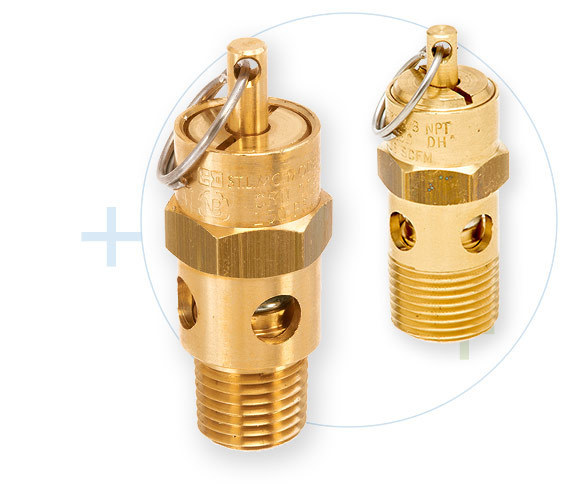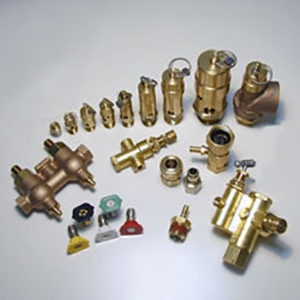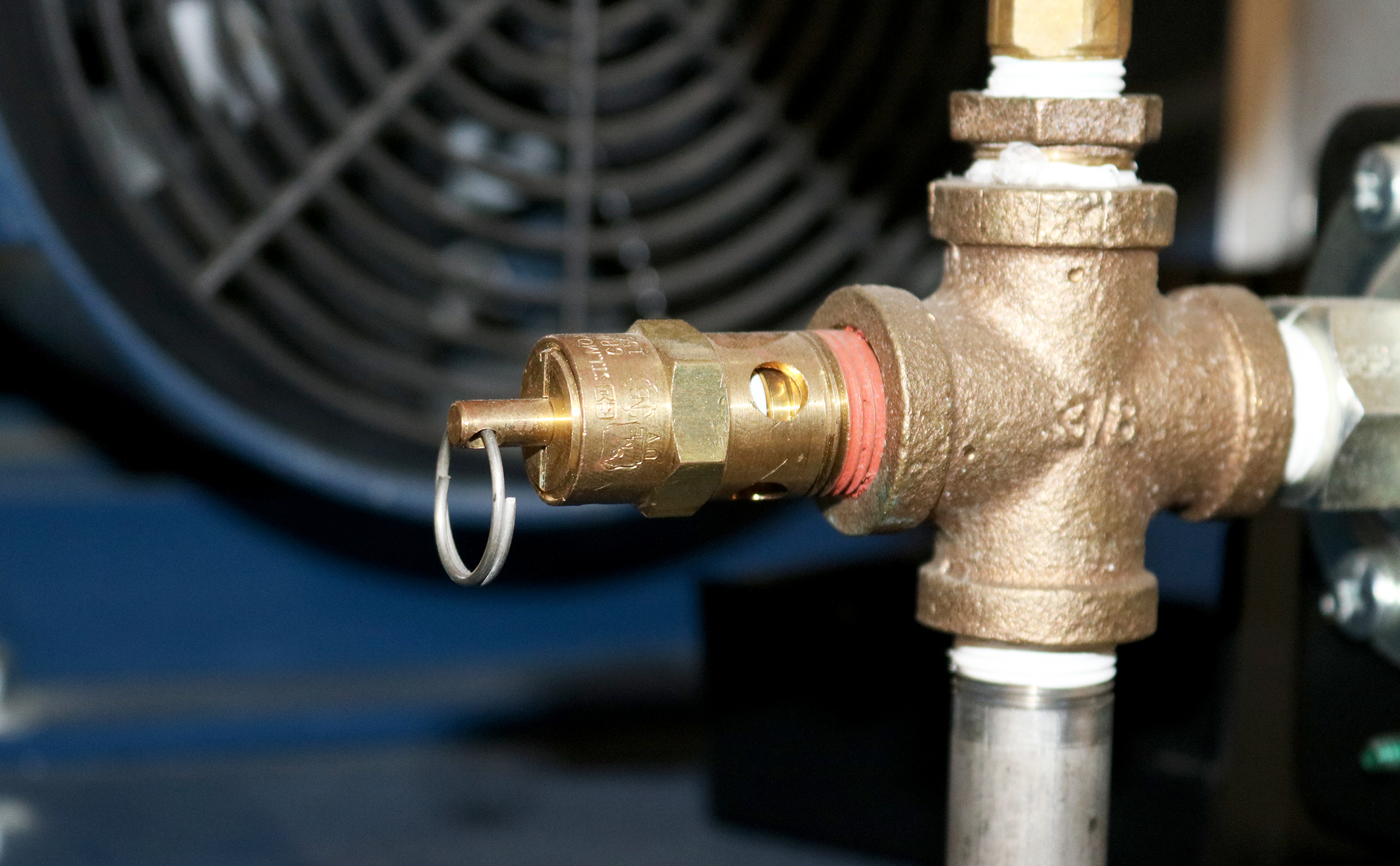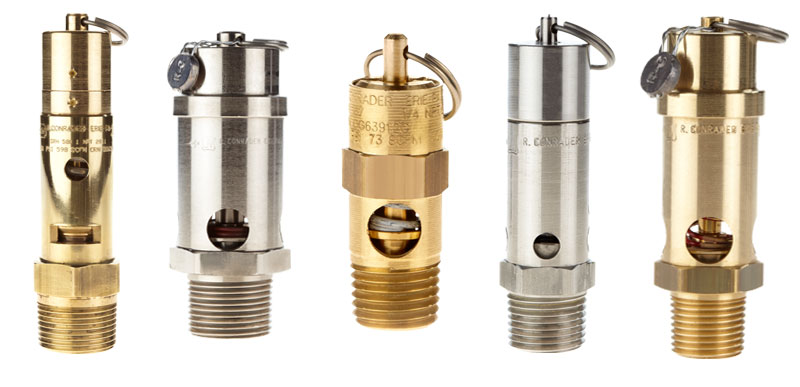air receiver safety valve manufacturer

You may not worry often, if at all, about whether or not your air compressor is running safely. And you really don’t have to, because compressor manufacturers do. From the pressure rating on the air storage tank to emergency stop buttons, air compressors are designed with safety in mind.
But that doesn’t mean you should never think about your compressor’s safety features. In most cases, they need to be inspected regularly to make sure they’re working properly. One key safety feature that should be inspected regularly is the air pressure relief valve (PRV), sometimes called a safety relief valve.
The pressure relief valve is a safety valve that protects the compressor component that it’s attached to from being exposed to a pressure above its rated maximum operating pressure. This rating, called the maximum working pressure (MWP), is the pressure that the vessel has been certified to continuously operate at safely.
So when a compressor is running at or below its maximum working pressure—in other words, when it’s running “normally”—the relief valve doesn’t do anything.
However, when the air pressure inside a compressor exceeds its MWP, the pressure relief valve will activate to “blow off” the excessive pressure within the compressor. Without a relief valve, the storage tank could rupture from the excessive pressure, damaging the compressor itself, possibly other property near it, and even causing injuries (or worse) to anyone standing nearby.
Before we can talk about how the air pressure relief valve works, we first need to look at how air pressure inside a compressor is managed when everything is running normally.
Under normal circumstances, the air pressure in a compressor is controlled by a pressure switch in an electro/mechanical control system or, in the case of an electronic controller, a pressure transducer and controller settings. When the cut-out set pressure for the pressure switch is reached, the compressor will stop compressing air (unload) until the cut-in set pressure is reached, at which time it will start compressing air again (load). If the pressure switch fails, the compressor would not be able to start compressing air again, or potentially worse, not be able to stop. Most compressors also have a high-pressure safety switch that should stop the compressor if the pressure exceeds the unload set point.
A pressure relief valve is a straightforward safety backup to the pressure switch and high-pressure switch, or the controller set points, should any of these components fail with the compressor running. The safety relief valve is set above the high-pressure safety switch and generally at or below the vessel’s maximum operating pressure. Inside the valve is a spring, and the pressure created by the spring’s tension keeps the valve closed under normal operating conditions. However, as the air pressure increases in pressure vessels (like the storage tank), it eventually exceeds the rated pressure of the relief valve, causing the relief valve to open and the excess pressure to be “blown off” to the atmosphere.
If the pressure relief valve fails open, air will continually vent to the atmosphere, preventing the air stream from becoming fully pressurized. The compressor should be shut down and the relief valve replaced before the compressor is restarted. The open relief valve will likely cause a loss of production and possible danger to personnel as a result of the flow of high-pressure air with flying debris and an unsafe sound level.
A pressure relief valve failing closed presents a potentially more dangerous situation. As noted earlier, the relief valve exists to allow excessive pressure to be “blown off” so that the air pressure inside the compressor’s pressure vessels don’t exceed their rated specifications. If the valve fails closed, this pressure venting can’t happen. Unless compressed air demand matches the compressed air supply, the pressure inside the compressor will continue to build. Eventually, the pressure increase would cause the storage tank to rupture, damaging the compressor and possibly causing additional damage and injury to property and people nearby.
If the relief valve is opening because the air pressure in the compressor has exceeded the valve’s pressure set point, that means the valve is working and doing what it was designed to do. But because this indicates the MWP of the compressor has been exceeded, the condition that’s causing excessive pressure should be diagnosed and corrected.
If the relief valve opening wasn’t caused by excessive pressure inside the compressor, then the valve is most likely “failing open”. Most likely, this is because the valve has become “soft” over time, i.e. the valve spring is providing less counterpressure, so it’s opening at a lower pressure than it should.
Whether the valve opened because of excessive pressure in the compressor or because the valve is failing, you should have your local air compressor distributor inspect your compressor before running it again for two reasons:
First, your distributor can determine whether the valve opened due to a failing relief valve or excessive compressors pressure and perform any needed maintenance or service to get your compressor running efficiently and safely again.
Second, regardless of why the pressure relief valve opened, replacing it may be recommended to ensure safe compressor operation, depending on the valve manufacturer. (Replacement is recommended for Sullair compressors.)
Important: Running the compressor after the relief valve has opened, regardless of the reason why it opened, can put both your property at risk of damage and people at risk of injury (or worse). While this may be obvious if the compressor is building up excess pressure, it also applies if the valve failed open. As noted above, even a valve that fails open poses some risk, and next time it could fail closed.
Given how critical a working air pressure relief valve is to the safe and efficient operation of your air compressor, you may wonder whether you need to do any regular inspecting or testing of the valve to make sure it is working. Because this can vary by manufacturer, you should consult your owner’s manual or contact your local air compressor distributor for frequency and type of inspection needed. For most Sullair compressors, inspection for damage or leakage is recommended, but testing is not recommended, as doing so may compromise the valve’s performance.
However, one thing you should do is schedule regular maintenance with your local air compressor distributor. As part of regular maintenance, a service technician can inspect the PRV and let you know it’s at an age or in a condition at which the manufacturer recommends replacement. Also, problems with the compressor’s performance, e.g. not reaching normal operating pressure, may help the service technician identify a failing relief valve after ruling out other possible causes.
When a pressure vessel like a receiver, sump tank or other storage vessel is purchased separately from the compressor, it may not be supplied with a pressure relief valve. To ensure its safe operation, you should add a PRV.
When selecting a PRV to add to the pressure vessel, you must choose a valve with a pressure set point set at or below the maximum working pressure of the vessel. You will find the MWP (and other useful information) on a tag welded to the pressure vessel. Also, flow capacity of the PRV must meet or exceed the total compressed air supplied to the vessel.
For example, if you have two compressors with capacities of 500 and 750 cfm (14.2 and 21.2 m³/min), and a pressure vessel with a maximum working pressure of 200 psi (13.8 bar), the minimum settings for a pressure relief valve would be 1250 cfm (35.4 m³/min) and a set point 200 psi (13.8 bar) or less.
Finally, when attaching the valve to the vessel, the porting must not be reduced to a size less than the size of the inlet port of the pressure relief valve.
Because the pressure relief valve is critical to the safe operation of your compressed air system, if you’re not sure how to select the correct PRV and properly and safely add it to the pressure vessel, contact your local air compressor distributor. They have the experience and expertise to ensure that the PRV is sized and installed correctly.

Any compressed air pressure vessel must be protected from an over-pressure situation - the maximum allowable working pressure (MAWP) approved by DOSH must not be exceeded. A pressure relief valve is used to limit the pressure build-up in a system, by automatically relieved by a spring-loaded valve, actuated by the static pressure upstream of the device. The valve opens in proportion to the increase in pressure over the opening pressure.
It is used to vent excess pressure which could rupture a pressure vessel. A pressure relief device is the last line of defense for safety If all other safety controls fail, the pressure relief device must be capable of venting excess pressure.

Established in 1983,A1 Pneumatics is the best-known firm involved in Manufacturer, Wholesalerand Service Provider of products likeAir Compressor, Air Compressor Rental, Brass Connectors.

We are the manufacturer and exporter of the Safety Valves, Ball Valves, Gate Valves, Globe Valves, Check Valves, Pipe Strainers, Industrial Valves, Safety Relief Valves, Pressure Reducing Valves and Digital Pressure Relief Valve.
Valve Size1/2 to 16 inchWe have gained a remarkable position in the industry by offering a qualitative assortment of Emergency Vent. Used to prevent excessive vapor pressure rise in the event of an external fire, dis vent is well known among our clients who are situated across the nation.
Emergency vent valves the importance of emergency venting in addition to the normal venting requirement by the valve / flame arrester. All large size above ground storage tanks needs emergency venting caused due to fire in adjoining area. The relief requirements are met by making provision of emergency pressure relief valves as per api standard.
Features of emergency vent valves for higher safety explosion caused by the above condition may be avoided by using pre"con emergency relief valve which allows the vapor to release to atmosphere. This emergency valves are weight loaded which is closed under normal conditions and open only when the set pressure is attained and release the excessive volume of vapor generated by above condition.
Model No316CWWe have gathered a huge customer base in dis domain by presenting a comprehensive range of Inconel 625 Safety Relief Valve.Other Details:Fd-Lok
We offer safety relief valves which are programmed to move the certain predetermined limits when it is in the process of releasing pressure. Our safety valves evade a lot of industrial accidents because of its improved safety processes.
ApplicationLiquid, water, Air and GasOur organization is placed among the noteworthy enterprise engaged in offering an excellent assortment of Brass Threaded Safety Valve.
Valve Size1/2 to 16 InchLeveraging on our in-house production unit, we are presenting a wide assortment Pressure Safety Valve.Product Details:Fluidtech Valves, Mumbai
FinishPolishedLeveraging on our in-house production unit, we are presenting a wide assortment of HighHigh Pressure Safety Relief Valve. Excellent quality control is one of our main principles. Our design, producing and testing strictly comply with the ISO9001 standard. Now our products are being exported all over the world.
FinishPolishedWe have gained a remarkable position in the industry by offering a qualitative assortment of Brass Safety Valve LeverPackaging Delivery:
Opening Pressure0 to 1600 BarOur organization takes pleasure to introduce its business as one of the leading entity offering Pressure Safety Valves. The offered valves are developed in accordance with industry norms and quality parameters. In the offered valves, our professionals use the approved material during the manufacturing process. In addition, these valves can be built and developed according to the specification provided by the clients. Furthermore, our professionals opt for strict quality inspection made on the valves to ensure high performance.
FinishPolishedWe have gathered a huge customer base in dis domain by presenting a comprehensive range of SS Super Duplex Safety Valves. The offered valves are programmed for moving certain predetermined limits at the time of releasing pressure, thus helping in avoiding a lot of industrial accidents coz as well as also providing for improved safety processes. Features:




 8613371530291
8613371530291